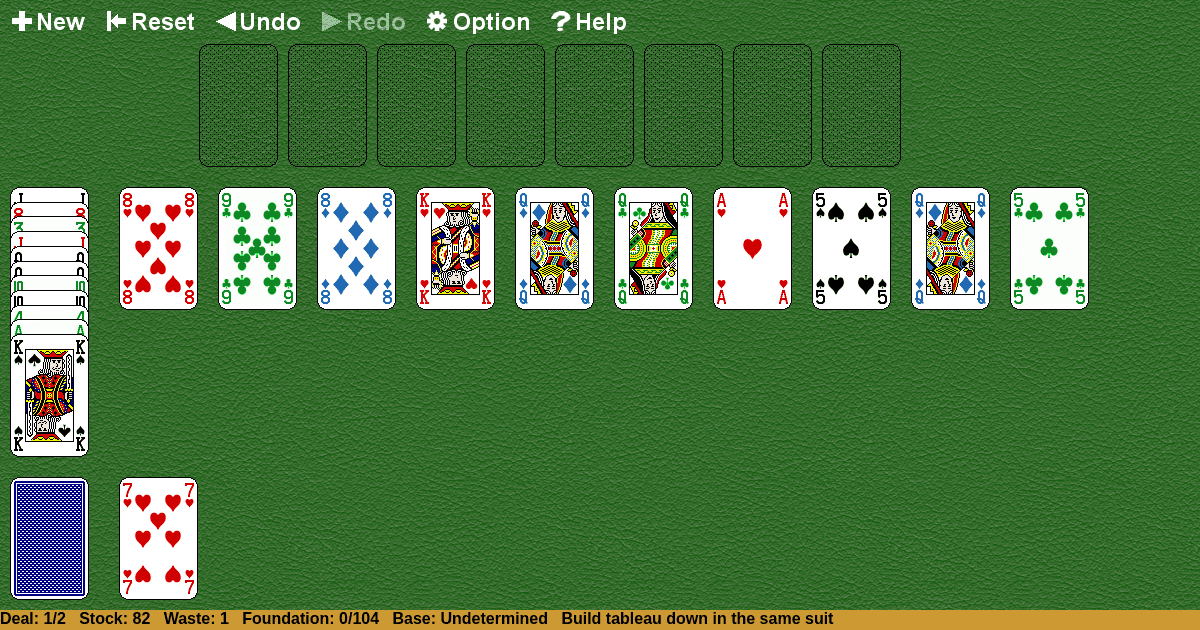Colonel
Home |
How to play |
FAQ |
About
How to play Colonel?
Game Objective:
The primary goal in Colonel Solitaire is to move all 104 cards (using two standard 52-card decks) to the eight foundation piles, building each foundation up by suit from Ace to King, including "around-the-corner" sequences (King to Ace).
Setup & Layout:
- Deck: Two standard 52-card decks (total 104 cards).
- Foundations: Eight empty piles, each to be built up by suit from Ace to King. The initial rank for each foundation is determined by the first card dealt to it.
- Tableau: Ten piles, each with one card dealt face up at the start. All tableau cards are visible.
- Reserve: One pile containing eleven cards dealt face up. Only the top card is available for play. Once empty, the reserve remains empty.
- Stock: The remaining cards after tableau and reserve setup. Cards in the stock are face down.
- Waste: Initially empty. Cards are dealt face up from the stock to the waste pile.
Key Play Areas Defined:
- Foundation: Where sequences are built up by suit.
- Tableau: Where cards are built down by suit; sequences can be moved.
- Reserve: Temporary holding area; only the top card is playable.
- Stock: Draw pile; supplies cards to the waste.
- Waste: Discard pile; only the top card is playable.
Colonel Solitaire Rules:
- Card Movement:
- Cards may be moved from the tableau, reserve, or waste to the foundations if they follow the suit and sequence rule.
- Tableau piles build down by suit (e.g., 10♠ on J♠).
- Sequences built down by suit in the tableau can be moved as a group.
- Only the top card of the reserve is playable, and only to the foundation.
- Cards from the waste or tableau may be added to tableau piles, following the build-down-by-suit rule.
- Building Sequences:
- Foundations: Build up by suit, starting with the initial rank (e.g., Ace), proceeding to King, and allowing "around-the-corner" (Ace after King).
- Tableau: Build down by suit. Only sequences built down by suit may be moved together.
- Empty Spaces:
- Empty tableau spaces are automatically filled from the waste, then the stock, then with any valid sequence or card if both are empty.
- Empty reserve spaces remain empty when depleted.
Gameplay:
- Turn Sequence:
- Move eligible cards from tableau, reserve, or waste to foundations or tableau, following suit and sequence rules.
- If no moves are available, deal one card from the stock to the waste pile.
- Continue moving cards and building sequences as allowed.
- Introducing New Cards:
- Cards are introduced into play by dealing from the stock to the waste. Only the top waste card is playable.
- Only one redeal of the waste back into the stock is permitted, allowing two complete passes through the stock.
- When No Moves Are Available:
- If no legal moves can be made and the stock is depleted, the game may become unwinnable.
Winning & Losing Conditions:
- Winning: The game is won when all 104 cards are successfully moved to the eight foundation piles, each built up by suit from Ace to King, including "around-the-corner" sequences.
- Losing/Unwinnable: The game is lost or becomes unwinnable if no further legal moves are possible and cards remain outside the foundations after all stock and waste cards have been played.
Special Rules & Edge Cases:
- Filling Empty Tableau Spaces:
- Automatically filled from the waste first, then the stock, then with any valid sequence or card if both are empty.
- Reserve Pile:
- Only the top card is playable, and only to the foundation. Once emptied, it cannot be refilled.
- Redeal Limitation:
- Only one redeal of the waste back into the stock is allowed.
- Around-the-Corner Building:
- Foundations allow Ace to be placed after King, continuing the sequence.
- Sequence Movement:
- Only sequences built down by suit in the tableau may be moved together as a unit.
- Foundation Filling:
- Empty foundation spaces may only be filled with the same initial rank dealt to the first pile at the start of the game.
Colonel Solitaire is a challenging double-deck solitaire variant requiring precise suit-based sequencing and strategic management of tableau, reserve, stock, and waste piles.

Solitaire Collection
About Colonel
Rate (Colonel)
4.7 / 5
1,916 votes



























































